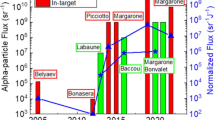Abstract
We report on the results of mass-spectroscopic analysis of the hydrogen yield from metals saturated with hydrogen under the action of accelerated electrons (with an energy of up to 100 keV and a current density from 3 to 30 μA). It is found that the desorption rate is determined not only by parameters of the electron bunch, but also by the structure of the oxide film. It is discovered that the electronic subsystem of hydrogen-enriched metals enhances their ability to absorb the energy of the external electromagnetic action and to preserve it for a longer time as compared to a pure metal. This facilitates nonequilibrium migration and yield of hydrogen under the action of radiation in the subthreshold range. A theoretical model is proposed and analytic dependences are derived for the intensity of hydrogen yield from metals exposed to an electron bunch. The results of this study can be used for the removal of hydrogen from metals and for obtaining submicrocrystalline materials (e.g., titanium).
Similar content being viewed by others
References
Hydrogen in Metals, Ed. by G. Alefeld and J. Volkl (Springer, New York, 1978; Mir, Moscow, 1981).
Yu. S. Nechaev, Usp. Fiz. Nauk 171, 1251 (2001) [Phys. Usp. 44, 1189 (2001)]; Usp. Fiz. Nauk 176, 581 (2006) [Phys. Usp. 49, 563 (2006)]; Usp. Fiz. Nauk 178, 709 (2008) [Phys. Usp. 51, 681 (2008)].
V. V. Ovchinnikov, Usp. Fiz. Nauk 178, 991 (2008) [Phys. Usp. 51, 855 (2008)].
A. M. Prognimak, Int. J. Hydrogen Energy 20, 449 (1995).
R. J. Elias, H. L. Corso, and J. L. Gervasioni, Int. J. Hydrogen Energy 27, 91 (2002).
E. A. Evard, I. E. Gabis, and A. P. Voyt, J. Alloys Compd. 404–406, 335 (2005).
E. M. B. Heller, A. M. Vredanberg, and D. O. Boerma, Appl. Surf. Sci. 253, 771 (2006).
Yu. Tyurin and I. P. Chernov, Int. J. Hydrogen Energy 57, 829 (2002).
Yu. I. Tyurin and I. P. Chernov, Fiz. Khim. Obrab. Mater., No. 2, 9 (1998).
E. Ya. Zandberg and N. I. Ionov, Surface Ionization (Nauka, Moscow, 1969; Israel Program for Scientific Translations, Jerusalem, 1971), p. 10.
R. Z. Valiev and I. V. Alexandrov, Nanostructured Materials: Fabrication, Structure, and Properties (Nauka, Moscow, 1999).
Author information
Authors and Affiliations
Corresponding author
Additional information
Original Russian Text © Yu.I. Tyurin, V.V. Larionov, I.P. Chernov, E.A. Sklyarova, 2011, published in Zhurnal Tekhnicheskoĭ Fiziki, 2011, Vol. 81, No. 1, pp. 35–41.
Rights and permissions
About this article
Cite this article
Tyurin, Y.I., Larionov, V.V., Chernov, I.P. et al. Features of excitation of the hydrogen (deuterium)-metal system by an electron bunch. Tech. Phys. 56, 30–37 (2011). https://doi.org/10.1134/S1063784211010245
Received:
Published:
Issue Date:
DOI: https://doi.org/10.1134/S1063784211010245




